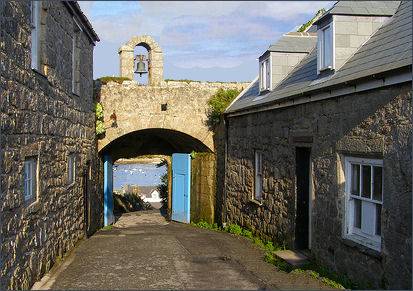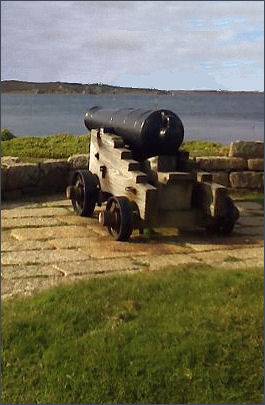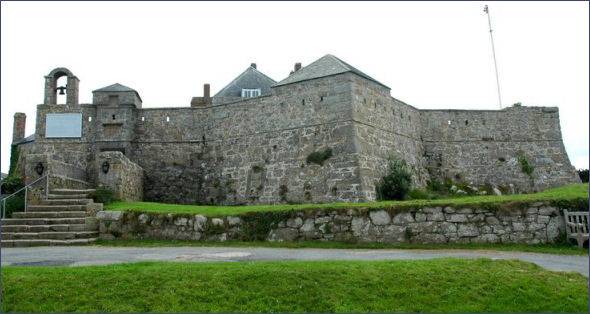The Garrison Walls, St. Mary's
OS grid reference :- SV 899 106
 The Garrison Walls around the west side of St. Mary's have a fascinating history that reaches back 350 years.
The Garrison Walls around the west side of St. Mary's have a fascinating history that reaches back 350 years.
 The first stretch of curtain wall was constructed in 1588, following the defeat of the Spanish Armada.
The possibility that the Isles of Scilly might be used as a base for attacks on shipping was realised in the 1550s, during the reign of the boy king Edward VI, but during much of the reign of Queen Elizabeth I (1558-1603) the islands' defences were neglected.
The first stretch of curtain wall was constructed in 1588, following the defeat of the Spanish Armada.
The possibility that the Isles of Scilly might be used as a base for attacks on shipping was realised in the 1550s, during the reign of the boy king Edward VI, but during much of the reign of Queen Elizabeth I (1558-1603) the islands' defences were neglected.
Nothing was done prior to the attack of the Armada in 1588, but the fear that the Catholic King Philip of Spain would launch a second armada to arttack England rendered it vital to take action. The Scillies had been leased to the Cornish Godolphin family, the governor of the islands, Sir Francis Godolphin, was presented with the task of building new fortification. Work was commenced at The Hugh, a prominent headland which juts out to the west from St Mary's.
At the centre of the fortification system was Star Castle, which takes the form of an eight pointed star and was constructed in 1593. To protect the castle on the landward side, a granite curtain wall was erected which crossed the neck of the headland from coast to coast, with four bastions and a fortified entrance.
During the English Civil War the Isles of Scilly were staunchly Royalist and supported the cause of King Charles I. Charles, Prince of Wales, (the future Charles II) stayed on the island for a few weeks in March 1646, after the final surrender of Royalist forces in the south-west of England, before he escaped to Jersey. A Parliamentary naval blockade forced the Royalists to surrender to Parliament in the following September.
 Two years later the Garrison rebelled and declared itself a Royalist stronghold. Sir John Grenville (1628-1701) was installed as the Royalist governor and under his command, Scilly became a major privateering base. The Dutch Navy was sustaining heavy losses from the Royalist privateers in Scilly. Admiral Maarten Harpertszoon Tromp (1597-1653) demanded reparation from the Royalist fleet for the Dutch ships and goods plundered by them. After receiving no satisfactory answer, The Netherlands declared war on the Isles of Scilly in 1651.
Two years later the Garrison rebelled and declared itself a Royalist stronghold. Sir John Grenville (1628-1701) was installed as the Royalist governor and under his command, Scilly became a major privateering base. The Dutch Navy was sustaining heavy losses from the Royalist privateers in Scilly. Admiral Maarten Harpertszoon Tromp (1597-1653) demanded reparation from the Royalist fleet for the Dutch ships and goods plundered by them. After receiving no satisfactory answer, The Netherlands declared war on the Isles of Scilly in 1651.
In 1651, a Parliamentary force under Admiral Blake and Sir George Ayscue captured Kings Charles' Castle whose defenders chose to blow it up to prevent its capture, the Parliamentarians then proceeded to take the Islands of Tresco and Bryher. Blake attacked the Royalist force at The Hugh, pounding the garrison shore. Although the Royalists rallied to Sir John Grenville's standard, the last Royalist bastion was finally forced to surrender at the beginning of June.
The possibility of an invasion by France or Spain remained during the seventeenth and early eighteenth centuries. The curtain wall was gradually extended until it surrounded almost the whole of the headland, with bastions covering every possible angle of approach from sea or land. The Godolphin family remained in charge, with most of the major work being carried out between 1715 and 1742 under the supervision of Abraham Tovey, the resident master gunner. Many of the surviving buildings on The Hugh date from this time, including workshops, stores and houses as well as defensive structures. Further strengthening of the headland took place between 1898 and 1901, when the massive Woolpack and Steval batteries were added, with the Greystones Barracks between them. Between 1902 and 1906 these were supplemented by the Steval Point Battery and, on the north-west coast of St Mary's, the Bant's Carn Battery, built for quick-firing guns.